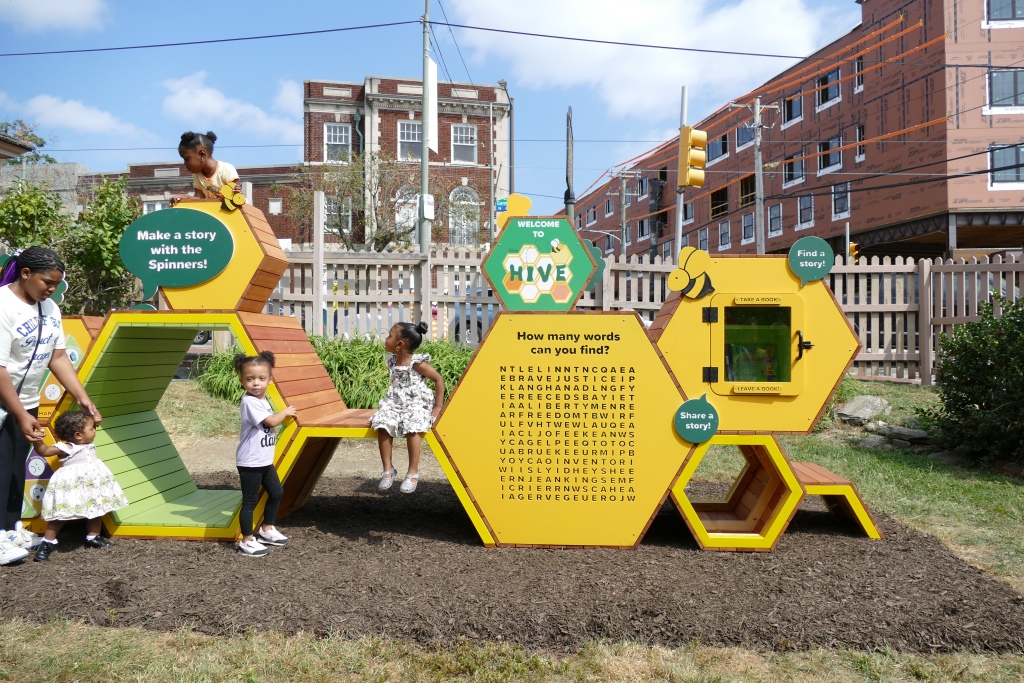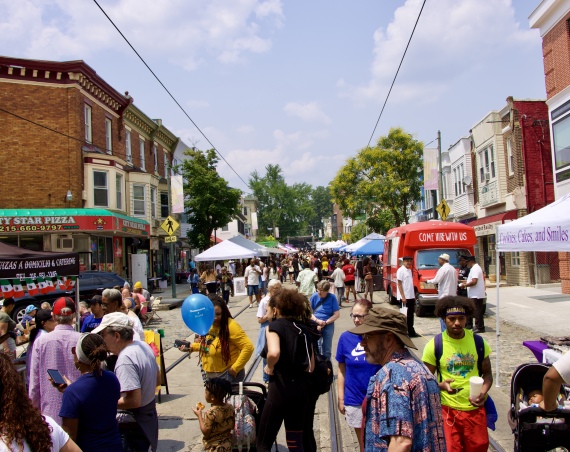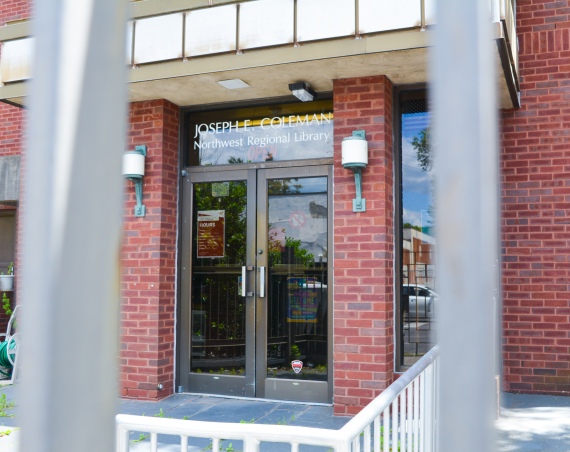
Two new playful learning installations have been placed in the Germantown neighborhood–one at the Wyck Historic House and one at the Johnson House Historic Site.
This was after an almost year-long process with a neighborhood advisory board of community leaders and neighbors dedicated to creating neighborhood spaces for children and caregivers to engage in literacy experiences. It’s all part of the Literacy Rich Neighborhood Initiative from the Mt. Airy CDC, which has been many years in the making.
It started with a summer reading camp at Holman Field in Germantown and continued to the installation of the first playful learning space, the Nest at Cliveden. With funding from the William Penn Foundation and partnerships with Interpret Green, KSS Architects, Playful Learning Landscapes Action Network, Watchdog, Weston Design & Fabrication Studio, and Drexel University, these two installations finish the trifecta of these public learning spaces.
The installations include Little Free Libraries, multiple seating options, I-Spy elements, story starters, a weather wheel station, word games, an audio story station, and much more.
Mt. Airy mom and local business owner, Cyn, was a liaison for the community advisory board, which met monthly and gave the designers and architects direct feedback about the new spaces. She was recommended for the group by her son’s previous teacher, who could see she was a very involved parent. She said the process was very interactive and played a major role in the finished products.
As the installations have been unveiled to the public, Cyn has enjoyed seeing the immediate way the designs were used in real life by visiting children.
She said, “As soon as we did the ribbon cutting, kids were going over to those things, and they were using them properly without even reading what is actually supposed to be there. They’re using the weather spinners. We have one of those things where you can use a cloud identifier. And it was perfect for the ribbon cutting day because it was a little cloudy and overcast, so we were able to actually identify what type of clouds they were and know that, hey, that’s amazing. It’s not going to rain today because that’s not a rain cloud like this.”
Philip Dawson, executive director of Mt. Airy CDC, knew the relationships built with Johnson House, Holman Field, and community leaders over the years led to the overall process and success of the installations.
Mt. Airy CDC had partnered with State Senator Art Haywood, the Pomona Cherokee Civic Council, and the Johnson House to provide a free reading camp for neighborhood kids. Dawson says even though the reading camps were impactful, at the end of the summer, the tent would come down, and it would be Holman Field again. With these new installations, community members can engage with interactive learning in public green spaces throughout the year.
“It gave us a way, without even having to insert ourselves in the classroom or the schools, just a way outside in the community where children and families are living day to day, to create in the public realm. To create installations that are going to spur curiosity and learning in just a very natural, organic way. It’s not telling a child that they have to sit down at a desk and be drilled on something,” said Dawson.
Another local mom and founder of the Koku-Roko Learning Co-op, Blew Kind, was also on the community advisory board. Kind loved how they provided dinner and compensation for all of the advisory members and welcomed the children into the process.
Together, they would attend the meetings, eat dinner, and, alongside their children, offer their thoughts and opinions. The children helped pick the shapes, colors, and what kind of interactive elements should be in the spaces.
It was important for Kind to have a physical component, and the hexagonal climbing spots are a big part of the structure of the Hive at Johnson House.
“I know with my youth, they need more physical spaces. They just love to climb, you know, and to literally, physically get their energy out in a positive way. So they did incorporate that,” she said.
The interactive elements sparking connection and conversation are also important to Kind. She values ways that deepen connections and vulnerability between humans, which extends to her relationship with her children. So, when she brought her children to one of the installations and her son answered a creative prompt about his favorite food, which she had never known, she loved how it brought her closer to her own family.
She and other advisory group members also ensured that the books and stories in the installations represented Black and Brown characters and their stories, knowing that Germantown is a majority Black neighborhood.
Both of the two chosen historic sites were pleased with the added value the installations give to their green spaces. Executive director of the Johnson House, Cornelia Swinson, notes that because of the Johnson House’s deep history as a center for social advocacy, the partnership also made sense on many levels.
“(Johnson House) was also a space where the Johnsons were involved in a lot of advocacy work, early advocacy work, quietly. So our history includes how they were on committees on education, healthcare, working with those who were unhoused, who needed food,” said Swinson.
Since 2015, the board voted officially to become a center for social advocacy and has continued to find opportunities to center that work in their programming. They also bring history, especially history starting in Africa, into their educational programming so Mt. Airy CDC knew they would be perfect partners in camp activities and installation.
As for Wyck’s grounds, executive director Kim Staub said the Wyck audience is changing, with more young families and daycares visiting their space regularly. Adults and children take advantage of their two-and-a-half acres to wander and explore. The Seeds & Bees installation blended perfectly with Wyck’s actual beehives and annual Honey Festival. It centered on a play structure that families could engage with as they interacted with the space.
Dawson is thrilled to see all the installations in place as part of their “Neighborhood as Story” theme, adding to their literacy-rich activities.
According to a counter they put at the site, The Nest at Cliveden has received an estimated 1600 visits in a six-month span. The installations are part of what their team has put together to enrich and build literacy skills throughout Northwest Philly.
The playful learning installations will be open whenever both sites are open. Wyck’s open hours are Tuesday through Friday, 10:00 a.m. to 4:00 p.m., and Saturday, 12:00 p.m. to 4:00 p.m. Johnson House’s hours are 10:00 a.m. to 4:00 p.m. on Thursday and Friday and 1:00 p.m. to 4:00 p.m. on Saturday, and by appointment.
A neighborhood tour of all three playful learning installations will start at the The Nest at Cliveden and visit each site on Thursday, October 10, 2024, from 4:00-5:30 p.m.



